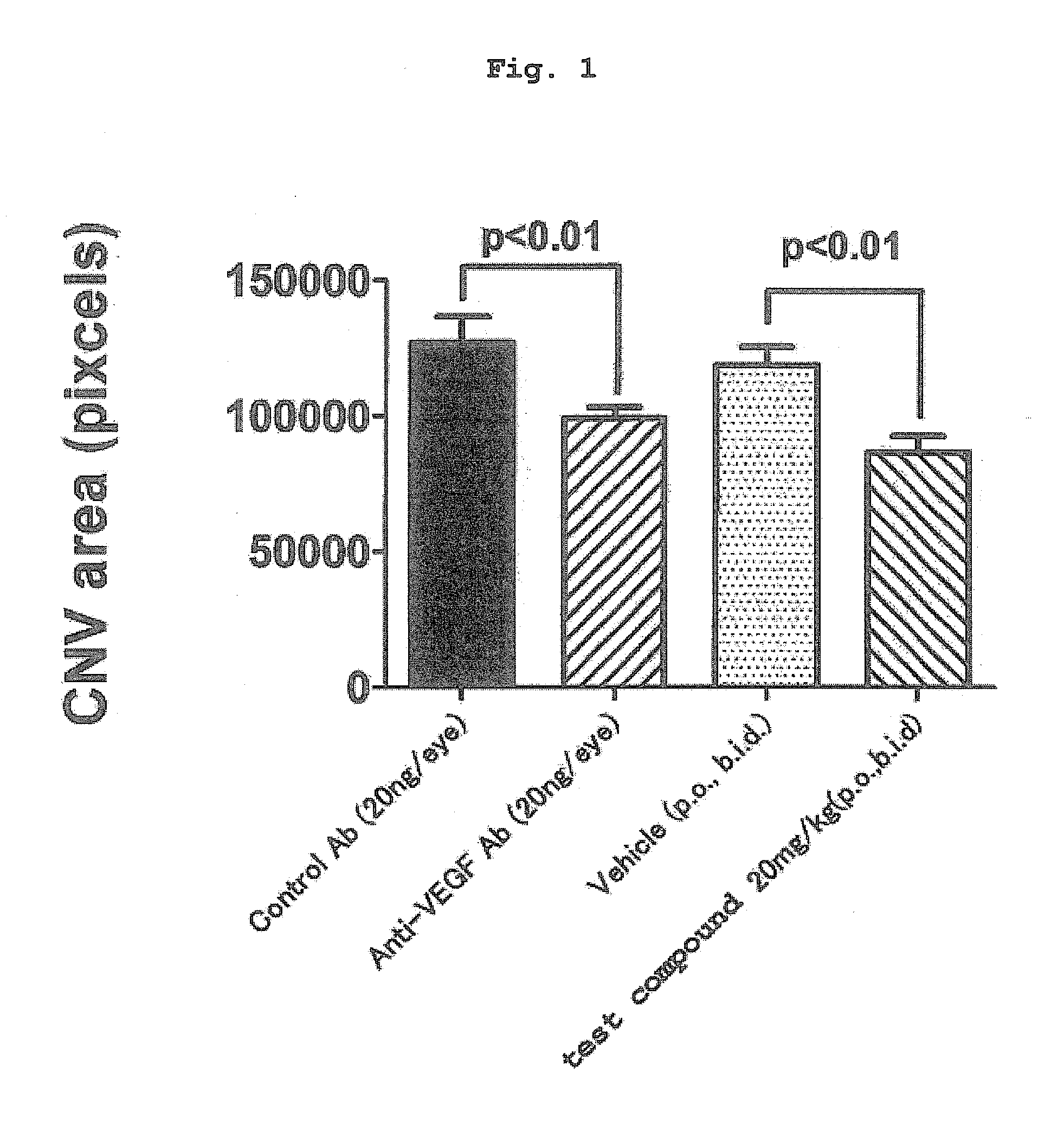Therapeutic agent for ophthalmic disease
a technology of ophthalmic disease and therapeutic agent, which is applied in the direction of drug composition, organic chemistry, senses disorder, etc., can solve the problems of bacterial infection, lens and retinal tissues are constantly exposed to the risk of ocular tissue damage, and patients are burdened with a lot of medical expenses, so as to suppress ocular angiogenesis
- Summary
- Abstract
- Description
- Claims
- Application Information
AI Technical Summary
Benefits of technology
Problems solved by technology
Method used
Image
Examples
synthetic example 1
Synthesis of (2S)—N-{[4-(3,4-dichlorobenzyl)morpholin-2-yl]methyl}chloroacetamide
[0185]2-{[(2R)-4-(3,4-dichlorobenzyl)morpholin-2-yl]methyl}-1H-isoindole-1,3-(2H)-dione (20.76 kg) was dissolved in 158.4 kg of ethanol, 4.82 kg of hydrazine was added dropwise over 6 min, whereby (2S)-2-aminomethyl-4-(3,4-dichlorobenzyl)morpholine was obtained. To said (2S)-2-aminomethyl-4-(3,4-dichlorobenzyl)morpholine was added 108 kg of toluene, and the mixture was concentrated to the total amount of 60 L, and 246.2 kg of ethanol was added. Thereto was added dropwise a solution of 4.62 kg of oxalic acid in 32.8 kg of ethanol over 1 hr 8 min to give 15.14 kg of (2S)-2-aminomethyl-4-(3,4-dichlorobenzyl)morpholine oxalate.
[0186](2S)-2-aminomethyl-4-(3,4-dichlorobenzyl)morpholine oxalate (14.70 kg) was dissolved in 38.0 kg of t-butylmethylether and 36.8 kg of water. Thereto was added dropwise 19.96 kg of 8N aqueous potassium hydroxide solution over 20 min. After separation of the reaction mixture into a...
synthetic example 2
Synthesis of (2S)-[4-(carboxymethyl)thiazol-2-ylthio]-N-{[4-(3,4-dichlorobenzyl)morpholin-2-yl]methyl}acetamide hydrobromide
[0187]4-Ethoxycarbonylmethyl-2-mercaptothiazole (8.18 kg) was dissolved in a mixed solvent of 22.80 kg of t-butanol and 25.72 kg of water, 13.2 kg of 8N sodium hydroxide was added dropwise over 15 min, and the mixture was stirred for 1 hr. Thereto was added the total amount of the solution of (2S)—N-{[4-(3,4-dichlorobenzyl)morpholin-2-yl]methyl}chloroacetamide in t-butylmethyl ether obtained in the above-mentioned Synthetic Example 1, whereby (2S)-[4-(carboxymethyl)thiazol-2-ylthio]-N-{[4-(3,4-dichlorobenzyl)morpholin-2-yl]methyl}acetamide was obtained. To said (2S)-[4-(carboxymethyl)thiazol-2-ylthio]-N-{[4-(3,4-dichlorobenzyl)morpholin-2-yl]methyl}acetamide was added 68.4 kg of t-butanol, and the mixture was concentrated to the total amount of 44 L, and 81.0 kg of acetonitrile was added thereto. Thereto was added dropwise 6.8 kg of hydrobromic acid over 33 min...
experimental example 1
Treatment Effect Relating to Angiogenesis
[0188]Using a mouse model experimentally induced to show choroidal neovascularization (hereinafter to be referred to as “CNV”) by laser irradiation (CNV model), efficacy relative to the CNV area was evaluated. The CNV model shows migration of macrophage by induction of inflammation by laser irradiation. As a result, VEGF is produced, and a new blood vessel is developed. Therefore, the CNV model is an experimental model showing the efficacy on a disease associated with ocular angiogenesis via VEGF.
[0189]Using (2S)-[4-(carboxymethyl)thiazol-2-ylthio]-N-{[4-(3,4-dichlorobenzyl)morpholin-2-yl]methyl}acetamide hydrobromide as a test compound, the following experiment was performed.
(Method)
[0190]Laser was irradiated (6 spot irradiation) on one eye of male C57BL / 6J mouse (7-week-old) to experimentally induce CNV.
[0191]The mouse was intramuscularly administered (1 mL / kg) with a ketamine hydrochloride / xylazine hydrochloride (1:1, v / v) mixed solution i...
PUM
| Property | Measurement | Unit |
|---|---|---|
| Electrical conductance | aaaaa | aaaaa |
Abstract
Description
Claims
Application Information
 Login to View More
Login to View More - R&D
- Intellectual Property
- Life Sciences
- Materials
- Tech Scout
- Unparalleled Data Quality
- Higher Quality Content
- 60% Fewer Hallucinations
Browse by: Latest US Patents, China's latest patents, Technical Efficacy Thesaurus, Application Domain, Technology Topic, Popular Technical Reports.
© 2025 PatSnap. All rights reserved.Legal|Privacy policy|Modern Slavery Act Transparency Statement|Sitemap|About US| Contact US: help@patsnap.com



